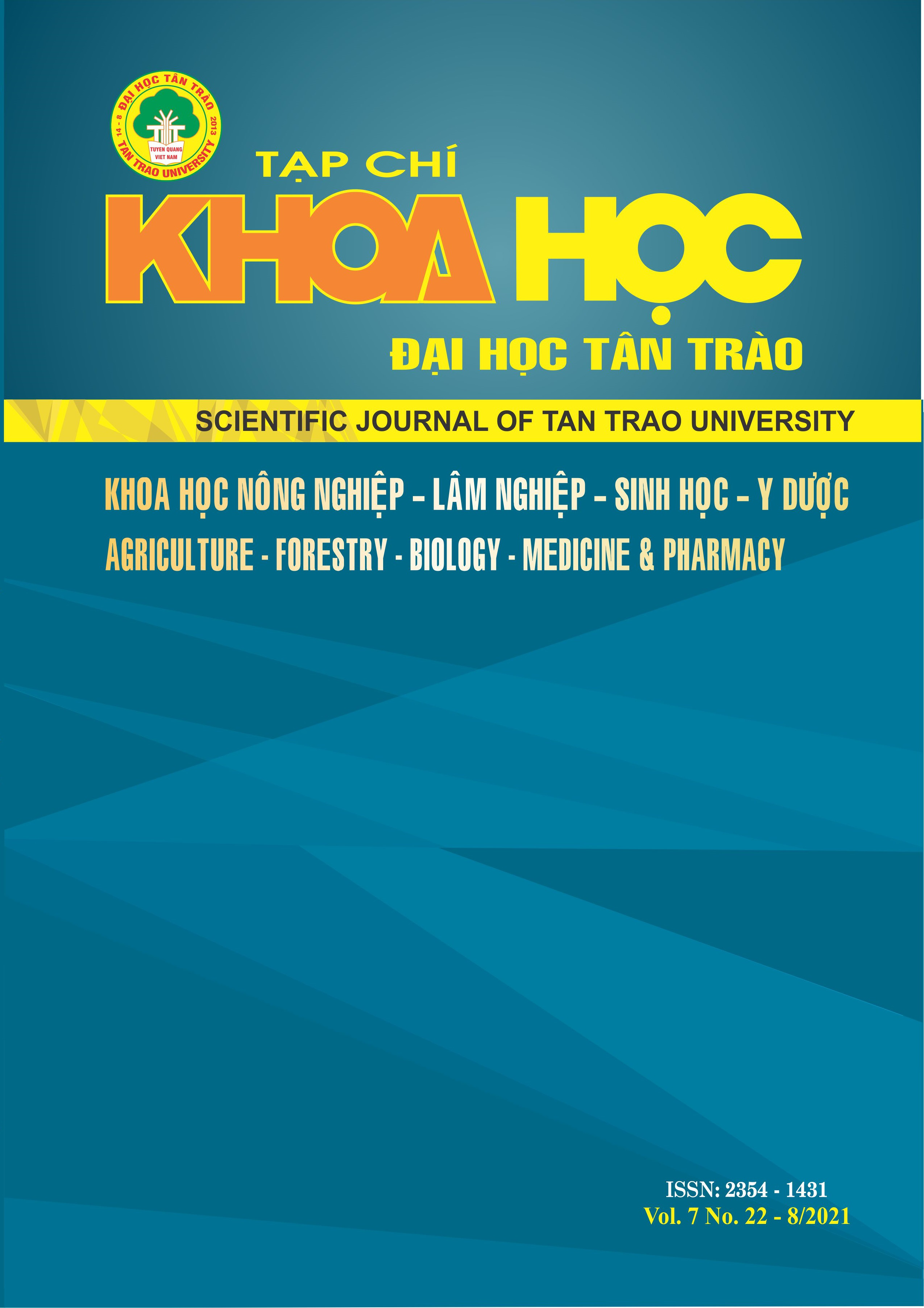NGHIÊN CỨU QUY TRÌNH CHẾ BIẾN TRÀ TÚI LỌC TỪ LÁ SÂM XUYÊN ĐÁ KHAI THÁC TẠI THÁI NGUYÊN
DOI:
https://doi.org/10.51453/2354-1431/2021/577Từ khóa:
Chế biến; quy trình; lá sâm xuyên đá; trà túi lá»c; thông số.Tóm tắt
Cây sâm xuyên đá tên khoa học Myxopyrum smilacifolium (Wall.) Blume, lá cây là chất làm se, chát, ngọt, sinh nhiệt, giảm đau, dị ứng, giải nhiệt và thuốc bổ… Hiện nay, sử dụng cây sâm xuyên đá chủ yếu chỉ sử dụng thân, rễ. Vì vậy việc nghiên cứu trà túi lọc từ lá sâm xuyên đá có ý nghĩa về khoa học và thực tiễn. Nghiên cứu cho thấy lá sâm xuyên đá có độ ẩm 69,95%, tro 2,15%, tanin 1,25%. Quy trình chế biến trà túi lọc từ lá sâm xuyên đá Thái Nguyên với các thông số kỹ thuật của các công đoạn chính như sau: Nhiệt độ sấy lá sâm xuyên đá là 70ºC, nghiền nguyên liệu với kích thước 1 < d ≤ 3 mm. Để tạo ra sản phẩm có chất lượng cảm quan tốt, cỏ ngọt, lạc tiên và nhân trần được bổ sung với tỷ lệ tương ứng 5%, 10% và 8%. Sản phẩm cho vi sinh vật hiếu khí 6,3.10⁴ vi khuẩn/ g, nấm men – nấm mốc 1,5.103 khuẩn lạc/ g đạt theo TCVN 7975 – 2008 về chè thảo mộc túi lọc.
Tải xuống
Tài liệu tham khảo
[1] Gopalakrishnan, S., Rajameena, R. (2013). GC- MS analysis of some bioactive constituents of the leaves of Myxopyrum serratulum A.W.Hill. International Journal of Advanced Research, 06:30-35.
[2] Madaleno, I. M. (2015). Traditional Medicinal Knowledge in India and Malaysia. Pharmacognosy Communications, 5(2):116-129.
[3] Maruthamuthu, V., Kandasamy, R. (2016). Phytochemical screening of secondary metabolites from Myxopyrum serratulum A.W.Hill by GC-MS, HPTLC analysis. International Research Journal of Pharmacy, 7(6):51-57.
[4] Siju, E. N., Samu, J., Minil, M., Rajalakshmi, G. R. (2017). Adaptogenic active component from Myxopyrum smilacifolium. International Journal of Current Pharmaceutical Research, 9(1):110-113.
[5] Ha, D. T. (2009). Food chemistry analysis. Science and Technology Publishing House, Hanoi. Vietnam.
[6] Thu, V. T. (2001). The chemical compounds in tea and some common analytical methods in tea production in Vietnam. Agriculture Publishing House, Vietnam.
[7] Hoang, V. C. (1999). Drying technique. Science and Technology Publishing House, Hanoi, Vietnam
Tải xuống
Đã Xuất bản
Cách trích dẫn
Số
Chuyên mục
Giấy phép

Tác phẩm này được cấp phép theo Giấy phép Quốc tế Creative Commons Attribution-ShareAlike 4.0 .
Bài báo được xuất bản ở Tạp chí Khoa học Đại học Tân Trào được cấp phép theo giấy phép Ghi công - Chia sẻ tương tự 4.0 Quốc tế (CC BY-SA). Theo đó, các tác giả khác có thể sao chép, chuyển đổi hay phân phối lại các bài báo này với mục đích hợp pháp trên mọi phương tiện, với điều kiện họ trích dẫn tác giả, Tạp chí Khoa học Đại học Tân Trào và đường link đến bản quyền; nêu rõ các thay đổi đã thực hiện và các nghiên cứu đăng lại được tiến hành theo cùng một bản quyền.
Bản quyền bài báo thuộc về các tác giả, không hạn chế số lượng. Tạp chí Khoa học Tân Trào được cấp giấy phép không độc quyền để xuất bản bài báo với tư cách nhà xuất bản nguồn, kèm theo quyền thương mại để in các bài báo cung cấp cho các thư viện và cá nhân.
Mặc dù các điều khoản của giấy phép CC BY-SA không dành cho các tác giả (với tư cách là người giữ bản quyền của bài báo, họ không bị hạn chế về quyền hạn), khi gửi bài tới Tạp chí Khoa học Đại học Tân Trào, tác giả cần đáp ứng quyền của độc giả, và cần cấp quyền cho bên thứ 3 sử dụng bài báo của họ trong phạm vi của giấy phép.


